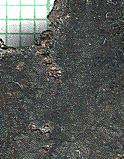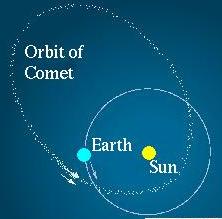More on Meteorites and Meteors
1) Chondrites. (right) contains rounded bits of glassy rock, called chondrules, (average diameter of 1 mm) of formerly melted minerals that have come together with other mineral matter to form a solid rock. Chondrites are believed to be among the oldest rocks in the solar system. 82% of meteorite falls are chondrites. What do chondrules look like up close? Click HERE
2) Carbonaceous Chondrites.These rare meteorites contain elemental carbon and other volatiles. In normal chondrites, these elements have been heated out. Thus, carbonaceous chondrites are more pristine, and are the least altered remains of the early solar nebula.
 3) Achondrites (left) contain no chondrites. They have likely been
heated sufficiently to melt any chondrites. Scientists
believe that some of these meteorites originated on
the surface of the Moon or Mars (the most famous Achondrite: ALH 84001).
3) Achondrites (left) contain no chondrites. They have likely been
heated sufficiently to melt any chondrites. Scientists
believe that some of these meteorites originated on
the surface of the Moon or Mars (the most famous Achondrite: ALH 84001).
Why the different Stony Meteorites?
Different histories. Normal Chondrites are heated only enough to
burn off volatiles but not destroy chondrites. Achondrites have been
heated quite significantly. In fact, achondrites are quite difficult
to separate from earth rocks, which have been similarly heated. Carbonaceous
Chondrites are the LEAST heated of all.
The fourth class of meteorites are 4) Iron Meteorites which are primarily iron and nickel (discussed on previous page). The final class is 5) Stony Iron, which is a mixture of iron and stony material (as listed above).

 The Origin of Meteors
The Origin of Meteors
Very small particles of material are typically responsible
for creating the meteors seen in the sky. These small bits of
dusty debris predominantly come from comets.
Over several billions of years, perhaps millions of comets
have come through the inner solar system, leaving behind a
debris trail as the ices holding them together melts near the
Sun. On any given night, one might see several small meteors
in an hour. If Earth's orbit happens to intersect the path of
a recent
comet, the debris trail will be dense, and one might
see hundreds to thousands of meteors per hour. This is
called a meteor shower
and the meteors will appear to radiate from a single point called the radiant
(for a still picture see here).
Meteor Showers are among the most beautiful astronomical phenomenon to experience as an amateur astronomer. To find out about upcoming major showers, you should go to this site: http://comets.amsmeteors.org/
The origin of Meteorites
Recall, meteorites are bits of space debris that survive entry
through Earth's atmosphere. These rocks are significantly more
sturdy and dense than the fluffy dust specks responsible for
typical meteors. Scientists studying the orbits of meteorites
as the fall to earth have discovered that they point back towards
the Asteroid Belt. Thus, meteorites (quite unlike meteors)
originate from dense rock bits which were once parts of asteroids
and in the last billion or so years, have broken off.